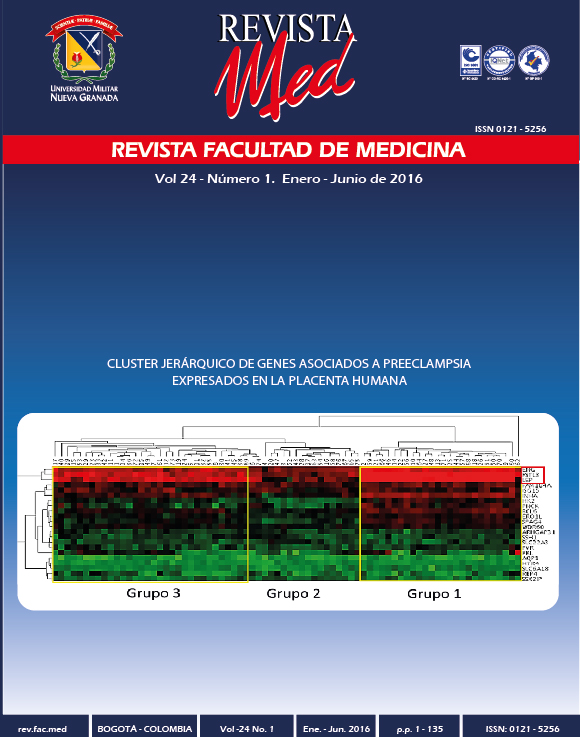Pathogens of urinary tract infection and host factors in pediatric population in a fourth level hospital from Bogotá-Colombia between 2006 and 2012
Abstract
Introduction: the urinary tract infection is one of the most common bacterial infections in children (representing 7%), and it´s early diagnosis and treatment could impact in complications. That is the reason why the empirical antibiotic used for treatment, is directed to the most frequent microorganisms. In the antibiogram revision, Escherichia coli (E. coli) sensibility reported in 2002 in The Military Central Hospital was satisfactory (86%) to continue the same first line of treatment (cephalotin) in children with febrile urinary tract infections. In many national and international studies has been reported an increase in the resistance to first level cephalosporins, with consequent changes in first line treatment. However, the changes in the sensibility in the last years in our hospital is unknown, also, if there are hostage factors that affect this changes in the sensibility.
Objective: determine the changes in bacterial sensibility in urinary infections and it´s relation with hostage factors in the pediatric patients of The Central Military Hospital between the years 2006-2012.
Materials and methods: retrospective cross-section study, including children between 0 and 14 years since January 2006 and December 2012, with confirmed diagnosis of urinary tract infection with positive urine culture depending on the recollection method. Were excluded those with incomplete information, immune-compromised, with oncologic or neurologic diseases. The data recollection included microorganism, sensibility and resistance to common antibiotics and hostage factors (age, gender, presence of fever, previous antibiotic treatment, obstructive diseases and urinary reflux).
Results: there were 271 infections, 79,9% by E. coli whose resistance to first level cephalosporins was low (18%) and moderate to TMP-SMX and ampicillin. For E. coli infections, the risk factors with more probability of presenting urinary tract infections resistant to first level cephalosporins are: fever (OR: 3.2), below 1 year of age (OR: 2.6), previous antibiotic treatment (OR: 1.2), urinary reflux (OR 1.5); and the risk factors related to multi-restistant urinary tract infections are: fever (OR: 10), recurrent urinary tract infection (OR: 1.4), below 1 year of age (OR: 2), previous antibiotic treatment (OR: 2.2), obstructive uropathy (OR: 2.2) and urinary reflux (OR: 2).
Conclusions: the global sensibility to first level cephalosporins is 82%, which is high. And following the risk factors analized we recomend: for febrile urinary tract infection we recommend first level cephalosporins. For unfebrile infections we recommend nitrofurantoin or nalidixic acid. If risk factors are present, program clinical control with urine culture to change or continue the treatment, because they have more risk for resistance.
Downloads
References
Hoberman A, Chao HP, Keller DM, Hickey R, Davis HW, Ellis D. Prevalence of urinary tract infection in febrile infants. J Pediatr. 1993; 123(1):17–23.http://dx.doi.org/10.1016/S0022-3476(05)81531-8
Shaw KN, Gorelick M, McGowan KL, Yakscoe NM, Schwartz JS. Prevalence of Urinary Tract Infection in Febrile Young Children in the Emergency Department. Pediatrics. 1998;102(2):e16.http://dx.doi.org/10.1542/peds.102.2.e16
Becker GJ. Reflux nephropathy: the glomerular lesion and progression of renal failure. Pediatr Nephrol 1993; 7(4):365–369.http://dx.doi.org/10.1007/BF00857540
Clark CJ, Kennedy WA, Shortliffe LD. Urinary Tract Infection in Children: When to Worry. Urol Clin N Am. 2010; 37(2):229–241.http://dx.doi.org/10.1016/j.ucl.2010.03.009
Prajapati BS, Prajapati RB, Patel PS. Advances in management of urinary tract infections. Indian J Pediatr 2008; 75(8):809–814.http://dx.doi.org/10.1007/s12098-008-0152-0
Quigley R. Diagnosis of urinary tract infections in children. Curr Opin Pediatr 2009; 21(2):194–198.http://dx.doi.org/10.1097/MOP.0b013e328326f702
Bhat RG, Katy TA, Place FC. Pediatric Urinary Tract Infections. Emerg Med Clin North Am. 2011; 29(3):637–653.http://dx.doi.org/10.1016/j.emc.2011.04.004
National Collaborating Centre for Women's and Children's Health (UK). Urinary Tract Infection in Children: Diagnosis, Treatment and Long-term Management. National Institute for Health and Clinical Excellence: Guidance. London: RCOG Press; Aug 2007.
Huertas RM, Reyes G. Estudio descriptivo de la respuesta clínica a la cefalotina en el tratamiento de la pielonefritis aguda en ni-os de 3 meses a 15 a-os en el Hospital Militar Central entre los a-os 1995 y 2001. Tesis posgrado. Bogotá: Repositorio Universidad Militar Nueva Granada. 2001
Lozano JM, Domínguez M, Marrugo T. Hallazgos paraclínicos y microbiológicos en infección urinaria en pediatría en el Hospital Universitario de San Ignacio. Universitas Med. 2000; 41:194-199.
Lozano JM, Parada MF, Bohórquez MC. Sensibilidad antibacteriana en infección urinaria en el Hospital Universitario de San Ignacio de Bogotá. Pediatria. 2003; 38:289-295.
Casta-o I, Gonzalez C, Buitrago ZY, De Rovetto C. Etiología y sensibilidad bacteriana en infección urinaria en ni-os. Hospital Infantil Club Noel y Hospital Universitario del Valle, Cali, Colombia. Colomb Med. 2007; 38(2):100-106
Bautista-Amorocho H, Súarez-Fragoso ND, Támara-Urrutia AM, Rodríguez-Villamizar LA. Etiología y susceptibilidad bacteriana a los antimicrobianos en ni-os con infecciones urinarias. Rev Mex Pediatr. 2009; 76(2):70-74.
Hoyos A, Serna L, Atehortúa P, Ortiz G, Aguirre J. Infección urinaria de la comunidad en pacientes pediátricos de la Clínica Universitaria Bolivariana. Etiología, presentación clínica, factores de riesgo y respuesta clínica a la terapia empírica inicial. Medicina UPB. 2010; 29(2):89-98.
Gallardo L, Maga-a M, Andrade HG, Jimenez MJ, Sánchez K, Fragoso LE. Resistencia a fármacos empleados en infección de vías urinarias en pacientes de primer contacto en una Unidad de Medicina Familiar del IMSS. Enf Inf Microbiol. 2008; 28 (1):13-18.
Shaikh N, Morone NE, Bost JE, Farrell MH. Prevalence of Urinary Tract Infection in Childhood A Meta-Analysis. Pediatr Infect Dis J. 2008; 27(4):302–308.http://dx.doi.org/10.1097/INF.0b013e31815e4122
Foxman B. Epidemiology of urinary tract infections: incidence, morbidity, and economic costs. Am J Med. 2002; 113(1A):5–13.http://dx.doi.org/10.1016/S0002-9343(02)01054-9
Zorc JJ, Levine DA, Platt SL, Dayan PS, Macias CG, Krief W, Schor J, Bank D, Shaw KN, Kuppermann N; Multicenter RSV-SBI Study Group of the Pediatric Emergency Medicine Collaborative Research Committee of the American Academy of Pediatrics. Clinical and demographic factors associated with urinary tract infection in young febrile infants. Pediatrics. 2005; 116(3):644–648.http://dx.doi.org/10.1542/peds.2004-1825
Yolbas I, Tekin R, Kelekci S, Tekin A, Okur M, Ece A, Gunes A, Sen V. Community-acquired urinary tract infections in children: pathogens, antibiotic susceptibility and seasonal changes. European Review for Medical and Pharmacological Sciences. 2013; 17:971-976
Alonso B, Bernadá M, Pereda M, Traversa M, Lechini R, Mari-o S, Perdomo V. Infección urinaria en ni-os: agentes patógenos y sensibilidad antibiótica. Arch Pediatr Urug 2001; 72(4): 268-273
Alsammani MA, Ahmed MI, Abdelatif NF. Bacterial Uropathogens Isolates and Antibiograms in Children Under 5 Years of Age. Med Arh. 2014; 68(4): 239-243http://dx.doi.org/10.5455/medarh.2014.68.239-243
Subcommittee on Urinary Tract Infection, Steering Committee on Quality Improvement and Management. Urinary Tract Infection: Clinical Practice Guideline for the Diagnosis and Management of the Initial UTI in Febrile Infants and Children 2 to 24 Months. Pediatrics. 2011;128 (3):595-610;http://dx.doi.org/10.1542/peds.2011-1330
Saadeh SA, Mattoo TK. Managing urinary tract infections. Pediatr Nephrol. 2011; 26(11):1967–1976.http://dx.doi.org/10.1007/s00467-011-1801-5
Price E, Pallett A, Gilbert RD, Williams C. Microbiological aspects of the UK National Institute for Health and Clinical Excellence (NICE) guidance on urinary tract infection in children. J Antimicrob Chemother 2010; 65:836–841http://dx.doi.org/10.1093/jac/dkq045
Heffner VA, Gorelick MH. Pediatric Urinary Tract Infection. Clin Ped Emerg Med. 2008; 9(4):233-237.http://dx.doi.org/10.1016/j.cpem.2008.09.009
American Academy of Pediatrics. Practice parameter: the diagnosis, treatment, and evaluation of the initial urinary tract infection in febrile infants and young children. Pediatrics. 1999; 103(4 Pt 1):843–852.
Hoberman A, Wald ER, Hickey RW, Baskin M, Charron M, Majd M, Kearney DH, Reynolds EA, Ruley J, Janosky JE. Oral versus initial intravenous therapy for urinary tract infections in young febrile children. Pediatrics. 1999; 104(1 Pt 1):79–86.http://dx.doi.org/10.1542/peds.104.1.79
Beetza R, Westenfelderb M. Antimicrobial therapy of urinary tract infections in children. Int J of Antimicrob Agents 2011; 38:42–50http://dx.doi.org/10.1016/j.ijantimicag.2011.09.006
Ammenti A, Cataldi L, Chimenz R, Fanos V, La Manna A, Marra G, Materassi M, Pecile P, Pennesi M, Pisanello L, Sica F, Toffolo A, Montini G. Febrile urinary tract infections in young children: recommendations for the diagnosis, treatment and follow-up. Acta Pædiatrica. 2012;101(5):451-7http://dx.doi.org/10.1111/j.1651-2227.2011.02549.x
Hewitt IK, Montini G. Pediatric febrile urinary tract infections: the current state of play. Ital J Pediatr. 2011;37:57-59http://dx.doi.org/10.1186/1824-7288-37-57
Tullus K. What do the latest guidelines tell us about UTIs in children under 2 years of age. Pediatr Nephrol. 2012;27(4):509-511http://dx.doi.org/10.1007/s00467-011-2077-5











